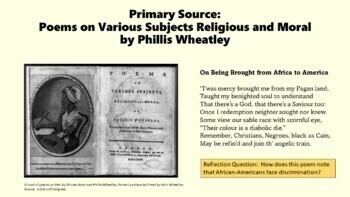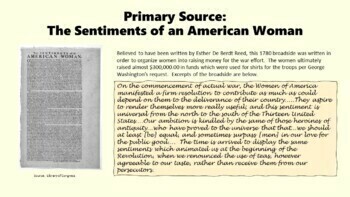Women of the American Revolution: PPT Lesson with Easel Activity and Assessment
- PDF
- Easel Activity
- Easel Assessment
What educators are saying
Also included in
- This resource bundle includes the following items: *Revolutionary Women: Power Point Lesson*Revolutionary Women: Reading Assignment and Worksheet*Revolutionary Women: Primary Source Analysis and DBQs Power Point LessonThis 13-slide PowerPoint presentation covers the Revolutionary Era between 1763 anPrice $7.20Original Price $8.00Save $0.80
Description
This 13-slide PowerPoint presentation covers the Revolutionary Era between 1763 and 1783. The Pre-Revolutionary Era lasted from 1763 through 1776 and the Revolutionary War lasted from 1776 to 1783. It is an ideal lesson for the Revolutionary War period or as a stand-alone resource for women’s history. The presentation includes descriptive text as well as primary sources. It is also a good resource during Women’s History Month.
Each slide contains information and graphics that highlight how women contributed during this period. Unlike during the Colonial Era, women began to take part politically, albeit in the form of writing or in choosing to boycott British goods. Nonetheless, it was a shift in women's roles in which women did not have a voice. This period challenged Americans to ask themselves what they sought in their new country. Not surprisingly, some women and African-Americans questioned whether they too should have equality in society. This question was not satisfactorily answered as a result of the war, but it did at least offer a platform wherein some people could pose the questions.
This file is in PDF but if you'd also like the Power Point file, please email me at cnonnemaker@gmail.com.
There is also an Easel Activity and Assessment. Whether for standard classroom use, Home Schoolers or for asynchronous learning, these are valuable digital tools. The Easel Activity includes a Speech Bubbles activity and a Talk With Someone from the Past activity. The Easel Assessment includes Multiple-Choie and True/False questions.
This is part of the Women in American History Series which includes PowerPoint lessons as well as Reading Assignments and Worksheets, Analyzing Primary Sources and Activities for other eras.
If you like World War II historical fiction, I have written a book called Hearts of War about a Nisei soldier who served in the Military Intelligence Service and a woman who served in the Women Army Corps. In writing this book, I wanted to bring an unknown aspect of history to light. Available on Amazon or Kindle and I appreciate any reviews!
Thank you!
Christa Nonnemaker







